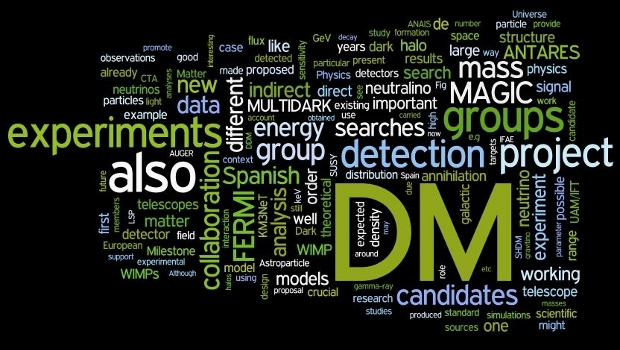|

One of the great scientific enigmas still unsolved is the existence of dark matter. Simple gravitational arguments allow to deduce that most of the mass in the Universe, about 85%, is some (unknown) non-luminous matter, implying that we are not made of what most of the Universe is made of.
Particle candidates for dark matter have been proposed all of which imply new physics. This is the case for example of the neutralino, sneutrino or gravitino, particles predicted by the supersymmetric extension of the standard model of particle physics. But other candidates have also been proposed.
The main goal of the proposed project is to contribute to the identification and detection of the dark matter. To this end, we propose
- to analyse in detail the most plausible candidates for dark matter,
- to investigate how they form the dark halos hosting the galaxies,
- to contribute to the development of experiments to detect the dark matter.
Experiments searching for these relic particles are carried out by many groups around the world. These experiments are becoming more sensitive every year. The dark matter could be detected directly in underground laboratories through its elastic interaction with nuclei inside detectors. The Spanish groups belonging to his project participate in ANAIS and ROSEBUD experiments in the Canfranc Laboratory, and in the long term European project EURECA.
There are also promising methods for the indirect detection of dark matter through the analysis of its annihilation products in the galactic halo or the Sun, such as gamma rays, antimatter and neutrinos. Atmospheric telescopes, satellites and neutrino telescopes are used for this purpose. Our groups participate in international collaborations such as the neutrino telescope ANTARES and its possible extension KM3NeT, the gamma-ray observatory MAGIC and the planned Cherenkov Telescope Array (CTA), the cosmic ray observatory AUGER, the projected experiment JEM-EUSO in the International Space Station, and it is also our aim to contribute to satellites such as FERMI and PAMELA.
On the other hand, the forthcoming onset of the world's largest and highest-energy particle accelerator, the LHC located in Geneva, will provide information about the nature of particle physics at high energy. Since most of the dark matter candidates can be created at precisely those energies, the combination of LHC data with those provided by direct and indirect searches in a multimessenger approach can be a crucial tool in its identification.
Finally, the SDSS-III international collaboration, where MultiDark participates, is carrying out the Baryon Oscillation Spectroscopic Survey (BOSS). BOSS will provide precision measurements of large and small-scale clustering, providing powerful constraints on the matter and energy contents of the Universe, studying the properties of dark matter halos; and it will put strong constraints on neutrino masses, and warm dark matter.
We therefore consider this is the right moment to strongly support the joint efforts of Spanish experimental and theoretical physicists, astrophysicists and cosmologists to take up the task from a multidisciplinary perspective.
|

